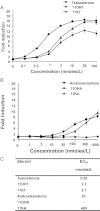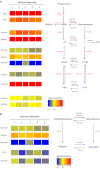Liquid chromatography-tandem mass spectrometry analysis of human adrenal vein 19-carbon steroids before and after ACTH stimulation
- PMID: 23386646
- PMCID: PMC3590473
- DOI: 10.1210/jc.2012-2912
Liquid chromatography-tandem mass spectrometry analysis of human adrenal vein 19-carbon steroids before and after ACTH stimulation
Abstract
Context: A broad analysis of adrenal gland-derived 19-carbon (C19) steroids has not been reported. This is the first study that uses liquid chromatography-tandem mass spectrometry to quantify 9 C19 steroids (androgens and their precursors), estrone, and estradiol in the adrenal vein (AV) of women, before and after ACTH stimulation.
Objective: The objective of this study was to define the adrenal androgen metabolome in women before and after ACTH infusion.
Design: This was a retrospective study.
Patients: Seven women, aged 50.4 ± 5.4 years, with suspected diagnosis of an adrenal aldosterone-producing adenoma were included in the study.
Methods: AV and iliac serum samples were collected before and after administration of ACTH (15 minutes). AV samples were analyzed using for concentrations of 9 unconjugated C19 steroids, estrone, and estradiol. Dehydroepiandrosterone sulfate (DHEA-S) was quantified by radioimmunoassay.
Results: AV levels of DHEA-S were the highest among the steroids measured. The most abundant unconjugated C19 steroids in AV were 11β-hydroxyandrostenedione (11OHA), dehydroepiandrosterone (DHEA), and androstenedione (A4). ACTH significantly increased the adrenal output of 9 of the 12 steroids that were measured. ACTH increased the mean AV concentration of DHEA-S by 5-fold, DHEA by 21-fold, A4 by 7-fold, and 11OHA by 5-fold. 11β-Hydroxytestosterone and testosterone were found to be potent androgen receptor agonists when tested with an androgen-responsive cell reporter model.
Conclusion: The current study indicates that the adrenal gland secretes primarily 3 weak androgens, namely DHEA, 11OHA, and A4. Active androgens, including testosterone and 11β-hydroxytestosterone, are also produced but to a lesser degree.
Figures


References
-
- Short RV. The secretion of sex hormones by the adrenal gland. Biochem Soc Symp. 1960;18:59–84 - PubMed
-
- Lombardo ME, Hudson PB. The biosynthesis of adrenocortical hormones by the human adrenal gland in vitro. Endocrinology. 1959;65:417–425 - PubMed
-
- Endoh A, Kristiansen SB, Casson PR, Buster JE, Hornsby PJ. The zona reticularis is the site of biosynthesis of dehydroepiandrosterone and dehydroepiandrosterone sulfate in the adult human adrenal cortex resulting from its low expression of 3β-hydroxysteroid dehydrogenase. J Clin Endocrinol Metab. 1996;81:3558–3565 - PubMed
-
- Holownia P, Owen EJ, Conway GS, Round J, Honour JW. Studies to confirm the source of 11β-hydroxyandrostenedione. J Steroid Biochem Mol Biol. 1992;41:875–880 - PubMed
Publication types
MeSH terms
Substances
Grants and funding
LinkOut - more resources
Full Text Sources
Other Literature Sources

